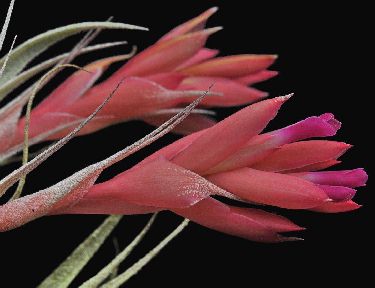
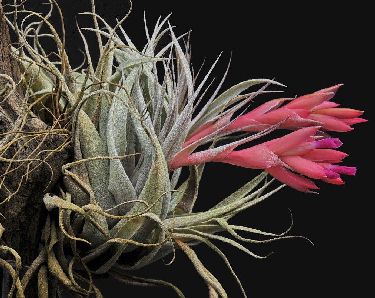
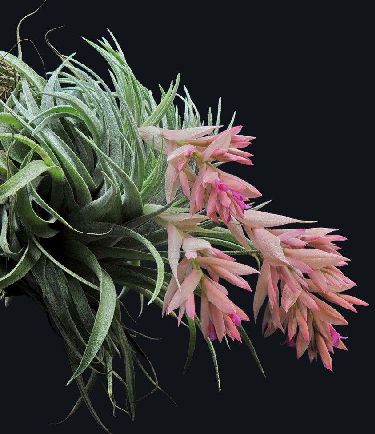
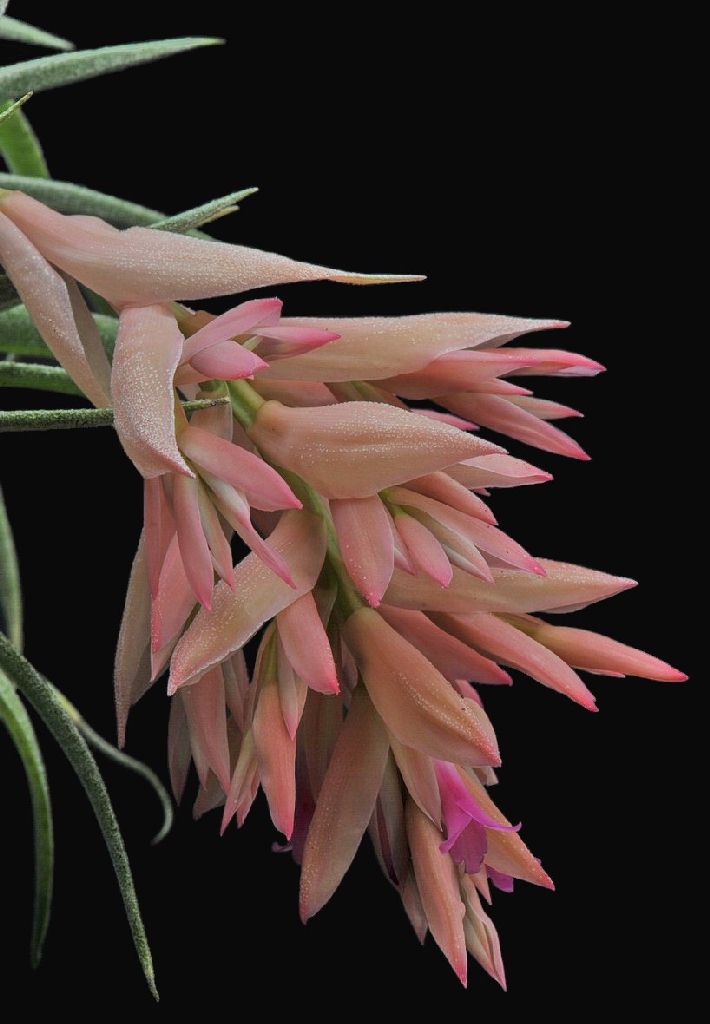
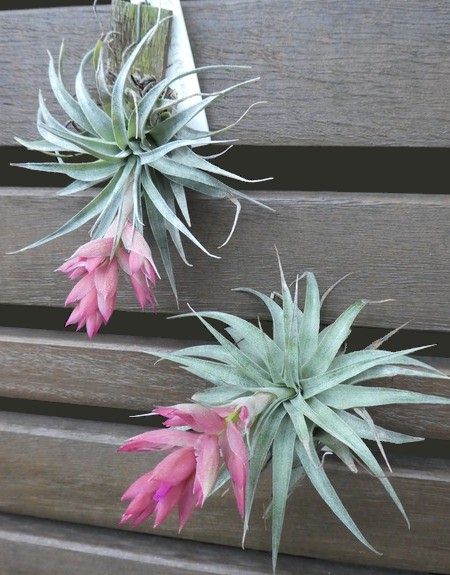
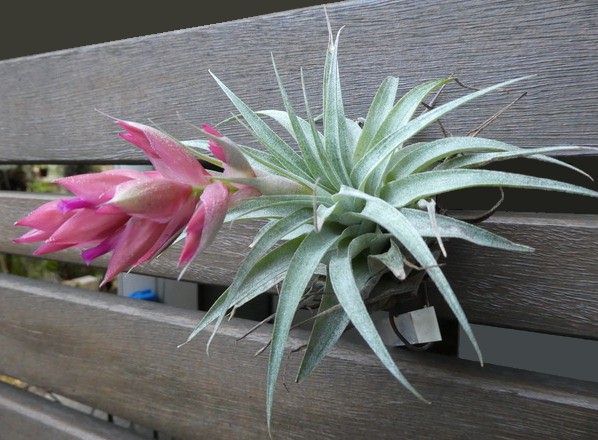
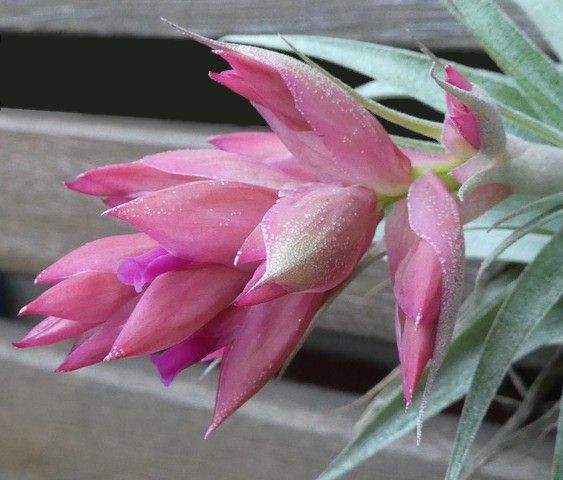
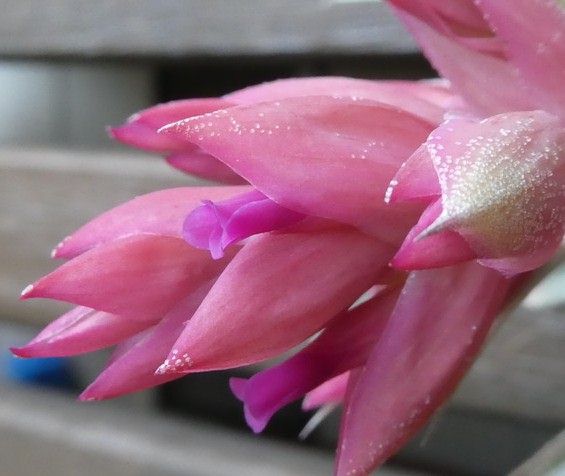
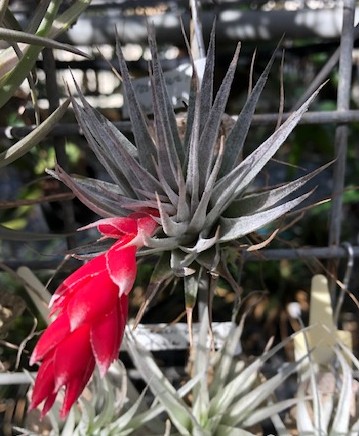
A tillandsia sprengeliana KLOTZSCH ex MEZ habitu majore minus bulboso, foliis longioribus latioribusque adpresse lepidotis cinereo-velutinis; bracteis scapi longioribus; inflorescentia majore spicis numerosis usque ad 5-floris longioriter stipitatis composita; bracteis florigeris longioribus distincte carinatis; sepalis longioribus adaxialiter distincte carinatis et petalis longioribus differt. Typus Brasilia Estado Rio de Janeiro, prope Nova Friburgo, 1200 m s. m., epiphytica, leg. K. & R. Ehlers, EB 81213, Julio 1981. (Holotypus: HB, Isotypus: WU); Estado Rio de Janeiro, Serra dos Organos, prope Petropolis, Mata do Facao, leg. E.M.C. Leme, s. n., 1986 (Paratypi: HB, WU).
Plant epiphytic, stemless, normally growing single but rarely in small groups, flowering 7 - 15 cm high, 6 - 15 cm wide, forming a slightly secund, subbulbous, sometimes (particularly in cultivation) wide dense rosette with many grey appressed lepidote leaves.
Leaves: up to 11 cm long, numerous (25 - 50), rather soft, dark green, resembling grey due to cinerous scales on both sides.
Sheath: 2 -3 cm long, 1 - 1.7 ( - 2) cm wide, elliptic, flat, little distinct from the blade, equally coloured as the blade, only the base glabrous, then both sides densely whitish-grey lepidote.
Blade: 3 - 7 cm long, narrow triangular acuminate, slightly canaliculate, with an indistinct keel, secund, sometimes spreading, both sides densely regular fine white lepidote, the margins with fine white trichomes, appearing uniform grey felt.
Scape: 3 - 5.5 cm long, 3 - 4 mm in diameter, shorter than the leaves and hidden by the rosette, ascending to curved, glabrous, covered by the sheaths of the subfoliate, imbricate, up to 7 cm long scape bracts;
internodes 7 - 9 mm, the almost erect blade 2 - 5 cm long, triangular caudate, densely lepidote like the leaves.
Inflorescence: exceeding the rosette, 5 - 8 ( - 10) cm long, 3 - 4 cm wide, oval, mostly bipinnate, seldom simple, with 7 - 16 densely erect spikes (rhachis not visible).
Spikes almost erect or spreading up to 45°,
Primary bracts: 2 - 5 cm long, 1.2 - 1.7 cm wide, the bottom ones longer than the spikes and caudate, the upper ones as long as the spikes or shorter and acuminate, the spikes enfolding the broad side and a large portion hidden, nerved, inside punctulate lepidote, outside pink, the tip fine white lepidote, towards apex always slightly lepidote.
Spike 2 - 4.5 cm long, 9 - 23 mm wide, complanate, 2 - 10 mm stipitate, 1 - 5 flowered with often an extra sterile stiped flower at the tip, the apical branch often reduced to one flower.
Floral bracts: 1.2 - 2.5 cm long, 8 - 12 mm wide, exceeding the sepals by about 2 mm, oval, acute, thin membranaceous with almost hyaline margins, nerved, carinate, inside scattered punctulate lepidote, outside bright red or yellowish-pink, mostly glabrous or scattered scales at the tip, some others having punctulate scales.
Sepals: 1.2 - 1.7 cm long, 3 - 4 mm wide, lanceolate acuminate, thin membranaceous, light green with pink tips, sligthly nerved, glabrous, free or the posterior pair connate for I - 2 mm and distinctly and prominently carinate.
Petals: 1.7 - 2.6 cm long, 2.5 - 3 mm wide, narrow oblanceolate, forming an erect tube with an open throat, the rounded tip spreading, upper one intensively violet - pink, the bottom one white.
Stamens: enclosed.
Filament 1.5 - 1.7 cm long, thin filiform, straight, white, equaling the style.
Anther 3 - 3.5 mm long, 0.5 mm wide, linear, fixed at base, light ochre coloured.
Pollen yellow.
Style 1.1 - 1.5 cm long, white, thin.
Stigma 1.5 x 1.5 mm. Lobes erect or spreading, pink.
Ovary 2 - 3 mm high, 1.5 - 2.5 mm wide, oval, green.
Differs from T. sprengeliana. KLOTZSCH ex MEZ:
Plant much larger, almost bulbose, cultivation often an almost broad rosette whilst T. sprengeliana retains its bulbose shape.
Leaves longer and wider, grey appressed lepidote and grey - velvet.
Scape bracts longer.
Inflorescence larger, with numerous, more flowered (up to 5), longer stipitated side branches.
Floral bracts longer, distinctly carinate.
Sepals longer, the posterior pair distinctly carinate.
Petals longer.
Differs from T. geminiflora BRONGNIART:
Leaves more secund and grey-lepidote.
Inflorescence dense.
Floral bracts surpassing the sepals,
Sepals glabrous and less connate.
Differs from T. organensis EHLERS:
Growing epiphytically;
Plant: bigger with more and bigger leaves.
Leaves grey-lepidote, not white-lepidote, with narrow-triangular blades. In cultivation the plants mostly loose the bulbous form while T. organensis remains bulbous.
Scape longer with longer scape bracts,
Inflorescence larger and more dense, the branches longer and composed of more flowers. Primary bracts bigger,
Floral bracts carinate.
Habitat: Brazil, relatively widely distributed, however not in great numbers, usually only a few plants.
Material studied: South of Rio in the Serra do Mar bought by Amanda Bleher; in Organ Mountain near Petropolis; Mata do Facao leg. Elton Leme, 1986; between Teresopolis and Novo Friburgo, 1200 m, EB 81213; between Petropolis and Teresopolis s. n. leg. Roser 1988; in Espirito Santo near Domingos Martins EB 8181.
In Washington Herbarium 1979 photographed by K. Ehlers; T. rosea Estado da Bahia s.n.; T. rosea 117, Teresopolis Organ Mountains; T. brachyphylla s.n. Road to Bahia; T. rosea?, T. globosa, Brazil, in trees in rainforest, leg. Mrs. Abendroth No.109, April 1959.
Comments: The plant has been for many years in culture in Brazil and Europe. It was exported by Amanda Bleher, an orchid and bromeliad nursery, under the name T. regnellii.
This small and beautiful grey Tillandsia was often confused with T. brachyphylla. So the plants shown in Werner Rauh "Bromelien", photo no.86, in the "Journal of the Bromeliad Society" July - August 1980 front page and in V. Padilla " The colorful Bromeliads", page 13-14 are identical with the now described T. roseiflora.
Wilhelm Weber received the plant from Amanda Bleher in 1971 and 1985 and made a botanical drawing. He was puzzled as to which plant it was related. The plant he got in 1971 he put near T. brachyphylla whereas the one he received in 1985 he noted T. aff. sprengeliana !
Key to Brazilian Tillandsias, with red or pink petals from Die Bromelie, Sonderheft 3 1996
1. Stamens - exceeding the flower tube => paraensis
- included in the flower tube => 2
2. Leaf blade - filiform and grasslike => globosa
- triangular => 3
3. Plant - 4-8cm in diameter => 8
- 10-25 cm in diameter, forming a more or less spreading rosette, stemless => 4
4. Floral bracts - lepidote => 5
- glabrous or nearly so: Plant 6-15cm diameter, inflorescence elliptic or globose, spikes elliptic, sublax with 1-3 (-5) flowers, floral bracts carinate, glabrous or punctulate lepidote, sepals glabrous => roseiflora
5. Inflorescence - elliptic or subglobose => 6
- elongate => 7
6. Leaves - soft, green or reddish, appressed lepidote, spike lax, 2-4 flowered, floral bracts shorter than sepals, petals red - violet => geminiflora
- soft, grey, densely lepidote with spreading trichomes, spikes dense, 3-12 flowered, floral bracts densely lepidote, exceeding the lepidote sepals => gardneri
7. Leaves - subsucculent, stiff, inflorescence with 4-6 spikes => chapeuensis
- Plant only 11-13cm in diameter, an open silvery star-shaped rosette, leaves appressed lepidote, inflorescence with 5-7 spikes => grazielae
8. Plant - short - caulescent => 9
- stemless, forming an erect, often subbulbose rosette, leaves often somewhat secund, inflorescence elliptic or subglobose, flowers red or violet, filament not plicate => 10
9. Plant - 3-5cm in diameter, pine cone shaped, dorsiventral, pendant, leaves green, silvery appressed lepidote, inflorescence simple, distichous => reclinata
- 4-8cm in diameter, an erect-secund rosette, the basal leaves recurved, leaves cinereous-lepidote, inflorescence compound, spikes lax, floral bracts carinate, shorter than the lepidote sepals, the posterior ones carinate and 4mm connate => sucrei
10. Floral bracts - glabrous or nearly so => 14
- lepidote => 11
11. Inflorescence - simple => 12
- bipinnate: Leaves channelled, regularly lepidote with coarse cinereous scales, inflorescence with up to 8 spikes which are laxly 3-4 flowered, the posterior sepals carinate, 1/3 to 1/2 connate, lithophytic growing at sea level => brachyphylla
12. Inflorescence - with polystichous flowers => 13
- with distichous flowers: Plant ca. 4cm in diameter, short caulescent, small pine cone shaped, pendant, leaves grey appressed lepidote => reclinata
13. Leaves - secund, thin and soft, grey with appressed trichomes, looking like grey velvet, scape densely lepidote, inflorescence simple, sometimes compound of up to 3 flowered spikes, floral bracts carmine-red, sepals slightly lepidote, free, posterior ones carinate, petals violet-rose => heubergeri
- Leaves not secund, subsucculent, green, covered with coarse grey scales, plant pendant, floral bracts rose, sepals more lepidote, petals pink => thiekenii
14. Posterior sepals - not carinate => 15
- carinate => 16
15. Leaves many, green-grey, densely lepidote with irregular cumulated coarse trichomes, appearing rough pruinose, epiphytic at sea level => sprengeliana
- Leaves many, narrow triangular, with appressed trichomes, appearing metallic, epiphytic 700-1000m => kautskyi
16. Plant - 2.5-5cm in diameter, rosette of broadly triangular leaves with shorter blade, very densely and regularly silvery subpruinose lepidote, appearing like silvery velvet, sepals carinate and short connate, lithophytic 1800-2200m => organensis
- Plant bigger, up to 15cm in diameter, rosette often bulbose, leaves grey - green appressed grey lepidote, appearing like grey velvet, bipinnate with 1-3 (-5 ) flowered spikes, floral bracts conspicuously carinate, posterior sepals carinate, epiphytic => roseiflora